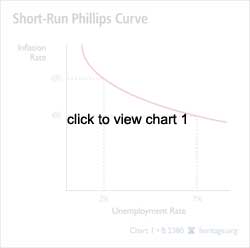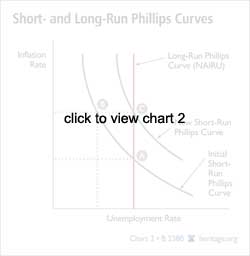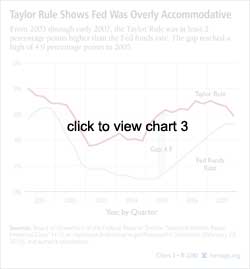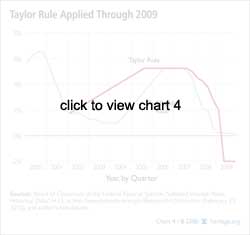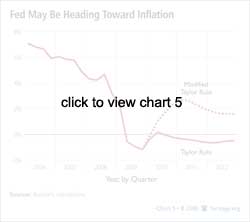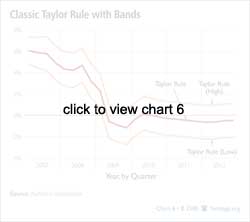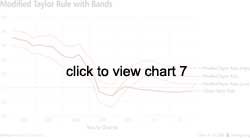Abstract: A mountain of excess bank reserves, now totaling more than $1 trillion, presents a real risk of rapid inflation if it is released too quickly into credit markets. The Federal Reserve appears to have the necessary tools to control the outflow of excess reserves, thereby restraining inflation. However, whether the Fed will use those tools wisely is an entirely separate issue. A related concern is the Fed's timing and aggressiveness in withdrawing its traditional monetary support for the economy by raising the Fed funds rate. Frequent comments by Fed officials and others regarding the downward pressure on inflation from persistent excess capacity in the economy suggest the Fed may be significantly tardy in withdrawing monetary support. If so, the Fed is risking the return of stagflation--high unemployment and high inflation. The danger can be clearly demonstrated through the classic Taylor Rule and in contrast to a modified Taylor Rule in which the effects of excess capacity dissipate over time.
Inflation--potentially rapid inflation--is knocking on the door. Will the Federal Reserve let it in? That is the great looming and unanswered question for U.S. monetary policy in 2010 and beyond.
Having suffered a deep recession and barely averted a thorough and crushing collapse of the global financial system, the U.S. economy continues to underperform badly. Capacity utilization is down about 10 percent, and the unemployment rate, hovering around 10 percent, is expected to remain elevated for years. Consequently, credible though waning residual concerns about near-term deflation persist.
Against this background of economic weakness, inflation may appear an odd concern, but it is not. Inflation is always and ultimately a monetary phenomenon. At some point, inflation's potential, created by past monetary policy, will be realized regardless of the state of the economy, either through offsetting policies or through a revival of potentially rapid inflation.
The actions of central banks around the world, especially the Federal Reserve, successfully stabilized the financial system in part through massive injections of reserves into the credit system. These reserves, which largely sit apparently idle on central bank balance sheets, assure financial institutions that they have the liquidity needed in a highly stressed financial environment. These reserves, now totaling more than $1 trillion, present the substance of the very real risk of rapid inflation if they are released too quickly into credit markets.
In addition, even if the Fed contains these excess reserves the economy faces a serious risk of inflation if the Fed is late in removing its traditional support for a weak economy. Before inflation becomes a reality, and likely well before the economy has established a firm footing, the Fed needs to address this inflation threat by beginning a difficult and judicious unwinding of the monetary stimulus that it applied since early in 2008--part of the Fed's so-called exit strategy. If the Fed errs, then not only inflation, but also another bout of stagflation, are likely.
Is the Fed Ready?
The policy question ultimately is in two parts. First, does the Fed have the tools for the task? As argued elsewhere and discussed briefly below, the answer is a tentative affirmative.[1] Second, will the Fed judge wisely both in using the tools and with respect to the consequences of failure?
Even aside from issues surrounding excess reserves, there is the more traditional question of whether the Fed will remove its ongoing support for the economy appropriately. Raising the Fed funds rate precipitously would undermine the recovery, while untoward delay would trigger a new rash of inflation concerns. History suggests the Fed was tardy in raising the funds rate following the recession at the start of the decade, and remarks by Fed officials about their current plans are disconcerting.
Fed officials, especially Chairman Ben Bernanke, have repeatedly affirmed their determination to respond to building inflation and inflation expectations if they arise. However, the complexity of the task and the uniqueness of the circumstances naturally raise concerns. An even greater concern, and the main subject of this paper, is monetary policymakers' apparent misconception that places excessive faith in the capacity of the weak economy to restrain inflationary pressures.
This misplaced faith in the persistent effects of high unemployment is explicit in a commonly referenced policy rule--the Taylor Rule. The rule may faithfully guide monetary policy under normal circumstances, but present conditions are fundamentally, even radically, different from those in which the Taylor Rule typically operates. Under the circumstances, the classic Taylor Rule may misguide monetary policy in ways that can be anticipated in advance.
Whether Fed officials are explicitly relying on the Taylor Rule or not, the rule clearly demonstrates the dangers of forgetting the basic lesson that inflation is ultimately indifferent to the state of the economy. Whatever their prior beliefs or preferred theories, Fed officials must move toward a more neutral policy to short-circuit inflationary pressures, which likely means moving sooner than they would prefer and sooner than their recent comments imply. The Fed needs to be as swift and decisive in preventing inflationary pressures as it ultimately was in responding to the recent financial crisis.
Inflation as a Monetary Phenomenon
Price stability has long been recognized as important to prosperity. In the modern era, price stability as a policy goal has been replaced by a close cousin: low, stable, and predictable inflation. The point of both is to ensure general price movements of goods and services are not a material factor in economic decision making. Low inflation means individuals and businesses need to spend little time or resources protecting against rapid price movements.[2]
The stability of the inflation rate is likewise important. When market participants confidently anticipate the overall rate of inflation, they can more readily interpret relative price movements. A stable inflation rate also means that market participants face one less fundamental uncertainty in making economic decisions. Low inflation is also more likely to be stable than high inflation, which tends to vary significantly and rapidly over time.[3]
As is now understood, "inflation is always and everywhere a monetary phenomenon."[4] Inflation ultimately results from too much money chasing too few goods, and in this sense the money in circulation is like any other good or service exchanged in the economy. If supply of a particular good outstrips demand, then the price of the good falls relative to everything else. In other words, the price of everything else rises relative to that particular good. The price of everything else rising relative to a dollar is just another definition of inflation.
The relationship between money creation and the price level is clear in the long run, but varies greatly in the short run. At certain times, even a hint that the Federal Reserve may waver in preserving low and stable inflation can cause inflation and inflation expectations to rise. In contrast, the Fed has been able to pump enormous quantities of liquidity or "money" into credit markets in recent months without triggering even a modest near-term uptick in inflation.
The Source of the Immediate Inflation Threat
During the recent financial crisis, the Federal Reserve responded through traditional means, such as lowering the Fed funds rate (the rate that banks charge each other in the United States for overnight lending) and the discount window rate (the rate that the Fed charges banks when it lends to banks to help them preserve a prudent level of reserves). The Fed began to lower the funds rate in late June 2006, first reducing the rate from 5.25 percent to 5.00 percent and then continuing to lower the funds rate until it effectively reached zero in December 2008. Over a similar period, the discount rate dropped from 6 percent to about zero.
The Fed adopted a great many other novel programs during the crisis to provide liquidity to specific firms and specific credit markets, including the purchase of vast quantities of mostly high-quality debt instruments.[5] These actions produced a massive expansion of excess reserves held by various financial institutions at the Fed.
Banks are required to keep a certain amount of reserves at the Fed based on the amount of their deposits. For example, in 2007, banks' required reserves averaged about $41 billion. Traditionally, banks would keep a modest amount of excess reserves on deposit at the Fed to avoid penalties for allowing their total deposits to fall below the required level. In 2007, banks' excess reserves averaged about $1.8 billion. By January 2010, excess reserves held at the Fed exceeded $1 trillion.[6]
As long as banks are content to leave their excess reserves at the Fed, this inflation threat is checked. However, once a bank withdraws reserves from the Fed, these reserves enter the credit-creation process, leading to a multiple expansion of the money supply through the fractional banking system.[7] In practice, this means that a small amount of reserves eventually becomes a large amount of money in the financial system.[8] For example, the narrowest measure of the money supply, defined as currency plus commercial bank reserves held at the Fed, averaged about $1 trillion in 2008. A common broad measure of the money supply--which also includes checkable deposits, savings accounts, money market funds, and similar instruments--averaged almost $8.7 trillion in 2008.
If the $1 trillion of excess bank reserves were released quickly into the financial system, it would soon become a multiple of that amount in circulation, creating a situation in which far too much money is chasing too few goods, and inflation would soar. As financial markets heal, banks will increasingly seek to draw down their balances of excess reserves to pursue greater profits by making private-sector loans.
The Fed's task is to control the release of these reserves to prevent an excessive outflow that could trigger a bout of inflation. As discussed briefly below and at greater length elsewhere,[9] the Fed appears to have the necessary tools for the task. The greater outstanding question, discussed later in this paper, is whether the Fed has the judgment to use those tools wisely.
Controlling Excess Reserves
Helping to control the outflow of excess reserves and, thus, the inflation threat is a tool that Congress recently granted to the Fed. The Financial Services Regulatory Relief Act of 2006 gives the Fed the authority to pay interest on excess reserves. The Fed currently pays a minimal 0.25 percent. However, if a bank with excess reserves deposited at the Fed wanted to withdraw those reserves to pursue more lucrative lending opportunities, the Fed could resist the withdrawal--and the resulting monetary expansion--by raising the interest rate it pays on reserves. If the Fed raises the interest rate sufficiently, the bank would be content to forgo the lending and instead earn safe interest at the Fed.
The ability to pay interest on excess reserves is as powerful as it is simple. In theory, the Fed should be able to control the rate at which excess reserves are withdrawn and applied to credit markets. This should be sufficient to allow the Fed's more traditional tool of raising and lowering the Fed funds rate (in conjunction with changes in the discount rate) to influence the pace of credit creation and inflation.
Having the tools and the intention to use them is no guarantee of success. Success also depends on execution: Will the Fed successfully execute its exit strategy to allow economic recovery while effectively restraining inflation? Despite the public assurances from Chairman Bernanke and his colleagues at the Fed, the Fed may be significantly late in responding to building inflation pressures. In fact, the likelihood the Fed will act too slowly is clearly embedded in these same public assurances. A lesson from history illuminates the issue--perhaps too well.
An Inflation Lesson from a Dark Era
Many years ago, a proposition called the "Phillips Curve" was widely accepted by economists.[10] The Phillips Curve suggested a stable relationship between inflation rates and unemployment rates, specifically that relatively high unemployment rates or excess capacity dampen inflationary pressures. Seeking to take advantage of this relationship, some economists counseled allowing inflation to increase slightly to reduce unemployment. For example, as shown in Chart 1, policymakers might choose to accept a monetary policy that increases inflation from 4 percent to a relatively high 6 percent rate to reduce the unemployment rate from 7 percent to 2 percent.
In the late 1960s and 1970s, policymakers followed this advice, expecting to exchange higher inflation rates for lower unemployment, but instead they achieved both higher inflation and higher unemployment rates: stagflation. From the first quarter of 1970 to the first quarter of 1981, the unemployment rate rose from 4.2 percent to 7.4 percent, and inflation nearly doubled from 5.5 percent to 10.3 percent. Higher inflation worked to reduce unemployment initially by surprising individuals and businesses, especially by artificially lowering labor compensation costs after inflation. Real wages fell, and more labor was hired. However, markets adapt quickly, and individuals and businesses soon came to expect higher inflation, thus neutralizing any downward pressures on unemployment rates.
This experience gave rise to an understanding of a distinction between a possible concave short-term Phillips Curve relationship and a vertical long-run Phillips Curve at the long-run rate of unemployment. Policymakers may believe that they can achieve lower unemployment with higher inflation, thus moving from point A to point B in Chart 2. Yet markets are not fooled indefinitely, so as they protect themselves from the distortions of higher inflation, the economy moves from point B to point C of higher inflation. Unemployment at the long-run rate of unemployment, which is determined by conditions specific to the labor market, is sometimes called the natural rate of unemployment or the non-accelerating inflationary rate of unemployment (NAIRU).[11] Worse, relatively high inflation is inherently distorting and costly, so the long-run result is that the vertical Phillips Curve shifts rightward so society reaps both higher unemployment and higher inflation.
Past episodes of relying on a Phillips Curve-like process stressed the false promise of lower unemployment at the cost of slightly higher inflation. Today, many Fed officials appear to be focusing on the converse effect: the promise of lower inflation due to high unemployment. For example:
-
"So we must begin to withdraw accommodation well before aggregate spending threatens to press against potential supply."
--Donald L. Kohn, Vice-Chairman, Board of Governors of the Federal Reserve System, September 2009[12]
-
"In light of increasing economic slack here and abroad, the Committee expects that inflation will remain subdued."
--Federal Open Market Committee Statement, March 2009[13]
-
"With substantial resource slack likely to continue to dampen cost pressures and with longer-term inflation expectations stable, the Committee expects that inflation will remain subdued."
--Federal Open Market Committee Statement, September 2009[14]
These comments parallel views expressed outside the Fed:
-
"Despite upward pressure from recovering commodity prices, global inflation is expected to remain subdued through 2010, held back by significant excess capacity."
--Dominique Strauss-Kahn, Managing Director, International Monetary Fund, July 2009[15]
-
"With a subdued recovery and substantial excess capacity (across the OECD), inflation is expected to continue to fall well into 2010."
--OECD Economic Outlook, November 2009[16]
Excess capacity in the economy may well dampen cost and price pressures for a period, but it will not do so indefinitely, as stagflation during the 1970s painfully demonstrated. To the extent that the Fed is relying on excess capacity and stable longer-term inflation expectations to restrain the current inflation rate, legitimate doubts arise about the Fed's judgment. Excess capacity is a fleeting source of restraint, while longer-term inflation expectations can shift overnight.
Policy Judgment and the Taylor Rule
Two common arguments trace to this focus on the counter-inflationary effects of persistent excess capacity and high unemployment. The first is the belief that businesses and workers typically have a difficult time increasing prices and wages broadly when the economy is experiencing significant excess capacity and unemployment. This intuitively appealing notion may well be valid over certain periods of time. In effect, it suggests monetary policy can be relatively more stimulative during periods of excess capacity. However, as the period of stagflation in the United States during the 1970s painfully demonstrated, economic weakness cannot ward off inflationary pressures indefinitely.
The second argument is that when the economy is experiencing excess capacity and inflation remains at or below a target level, monetary policy should be relatively more stimulative through a lower Fed funds rate. This view is well captured by the popular Taylor Rule for monetary policy. The Taylor Rule, which explicitly or implicitly guides central bank practice in much of the world, relies on excess inflation and excess capacity to prescribe the Fed funds rate. The Taylor Rule, or at least some of the principles it reflects, also appears to influence Fed policy to an extent, as suggested by the public comments listed above.
The Taylor Rule can be written:
R = i + r + a(y) + b(i - i*)
where
R = the Fed funds rate
i = the current rate of inflation
i* = the target rate of inflation
r = the natural rate of interest
y = the output gap, or the difference between actual and potential output.[17]
The intuition behind the Taylor Rule is straightforward. When the economy is in equilibrium, with output at its potential (full employment) and inflation at its target rate, the Fed funds rate should be neutrally accommodative and set at the rate of inflation plus the natural rate of interest. Inflation above the target rate indicates a need for monetary tightening, so the Fed funds rate should be higher than its neutral rate, whereas if the economy is operating below its potential, the Fed funds rate should be lower.
The Taylor Rule has been used to argue that the overly accommodative monetary policy from 2003 to 2006 played a major role in contributing to the housing bubble and excessive reliance on debt generally led to the financial collapse later in the decade.[18] A brief review of this discussion is useful here as a precursor to the discussion to follow.
Using the Taylor Rule, John B. Taylor has argued that the Fed overreacted to the recession at the start of the decade by lowering the Fed funds rate to 1 percent and then was much too slow in raising the funds rate as the economy recovered.[19] In contrast, Bernanke has argued that the Taylor Rule is operationally subject to significant limitations--some of which are discussed below--and that the extent to which monetary policy was overly accommodative is very much open to question.[20]
The debate over the stance of monetary policy early in the decade is fundamentally a debate over degree. As Chart 3 shows, the Fed funds rate was significantly and persistently below the rate prescribed by a common application of the Taylor Rule.[21] On the other hand, Bernanke suggests that if the measure of current inflation in the Taylor Rule is replaced with an inflation forecast, then the resulting trajectory of the Fed funds rate more closely approximates the Fed's policy over this period. Numerous causes have been cited for the speculative bubbles that led to the Great Contagion, and the debate over the Fed's role will likely continue for years, but at this point, it seems clear that the Fed's overly accommodative stance over an extended period was at least a substantial contributor.
Some of the strengths and weaknesses of the Taylor Rule are on further display from the end of 2006 to the end of 2009. The strengths are shown in that the Taylor Rule prescribes rapid reductions in the funds rate beginning around the start of 2007 and continuing until the funds rate is theoretically negative beginning in the second quarter of 2008, roughly coinciding with the collapse of the investment firm Bear Stearns. Of course, a negative Fed funds rate is impossible, but the Fed was able to continue to pursue an even more accommodative policy through quantitative easing.[22]
A weakness of the Taylor Rule is that the prescription for the funds rate can be distorted by nonmonetary external events, such as a rise in oil prices that temporarily raises the reported inflation rate without increasing trend inflation. This occurred in 2008, leading the Taylor Rule to prescribe a sustained high rate for the funds rate even as the financial crisis accelerated. In contrast to the Taylor Rule prescription, the Fed rapidly cut the funds rate, although still too slowly.
The Taylor Rule in Light of Persistent Excess Capacity
The Taylor Rule is a relatively recent major development in the ongoing debate of rules versus discretion in setting monetary policy. Whether one advocates a gold standard, a fixed exchange rate, a fixed rate of growth of a monetary aggregate such as the money base, or a predetermined policy rule for the Fed funds rate, one is advocating a monetary rule. Rules are appealing because they denude government of a fundamental power: the power, intentionally or not, to inflate prices and devalue a currency. They are also appealing because rules provide a welcome degree of certainty to markets with respect to what the central bank is doing or likely to do.
The abiding difficulty with monetary rules of any kind is that they cannot anticipate every type of shock an economy will likely face. Moreover, markets are constantly evolving, so a rule that works perfectly at one time may fail terribly later. An alternative to rules dictating a central bank's actions is to establish a credible outcome that the central bank seeks to achieve, such as a target rate of inflation.
Of course, defining outcomes and defining rules need not be in conflict. The Taylor Rule establishes a rule in part by incorporating a desired outcome: the target rate of inflation. Yet credible defined outcomes, such as a target rate of inflation, allow monetary authorities greater freedom to respond to unexpected situations, like the recent crisis, or surprising evolutions in money and banking that would render a fixed rule harmful. Further, credible defined outcomes still achieve the dual benefits of depriving the central bank of the power to devalue the currency and providing markets with a degree of certainty.
Rules are useful whether applied mechanically, used as guides, or used merely as additional information for the monetary authority to consider. In the present study, the Taylor Rule is also useful in demonstrating an apparent error that is developing in monetary policy.
Much of the research and commentary on the Taylor Rule involves the possibility of altering the basic formula and the choice of values for the coefficients. In many respects, the debate over the specification of the Taylor Rule is a debate over the best rule to use over time when the economy is more or less in equilibrium. Under present conditions and in light of historical experience, an important modification to the Taylor Rule appears to be in order.
While most of the debate over the Taylor Rule involves specification issues of fixed parameters, nothing about the rule suggests that the parameters themselves must be constant through all stages of every conceivable circumstance. This is a matter not of abandoning the principle of having a pre-specified rule guiding monetary policy, but rather of having a dynamic rule reflecting dynamic circumstances.
Taylor argues that the form of the rule derives from experiments in optimal control theory.[23] Even so, including excess capacity in the rule in some fashion lends itself to ready intuitive explanation. First, excess capacity may, for a period, put downward pressure on inflationary tendencies. Second, monetary policy is one tool to which policymakers may turn to support the real economy during periods of weakness or to restrain the economy if it appears to be overheating. Importantly, these are not long-term considerations, although how relevant they may be in the short term is open to question.
Monetary policy affects the trajectory of the real economy in modern neo-Keynesian-style models because they incorporate sticky prices in some fashion. In general, business cycles result because some quantities or prices in a market or markets are unable to adjust downward rapidly in response to changing circumstances. Wages and salaries are common examples of prices that resist downward movements. Imbalances then quickly build, leading to layoffs and further imbalances as the dislocations spread. However, even in these models, price stickiness is time-limited. Eventually, prices and quantities adjust, and imbalances correct. Thus, the ability of monetary policy to influence the real economy is likewise limited.
In terms of the Taylor Rule, this means that the two justifications for including excess capacity as a determinant of the Fed funds rate apply for a limited period. Thereafter, in some fashion, the coefficient on excess capacity in the Taylor Rule should decline, likely to zero.
The following experiment demonstrates the implications of this alternative treatment of excess capacity in the Taylor Rule. In constructing the experiment, forecasts of actual and potential output are taken from the Congressional Budget Office's August 2009 Report. The CBO forecasts for GDP price index inflation in 2010, 2011, and 2012 to 2013 are 0.8 percent, 0.3 percent, and 0.7 percent, respectively. These forecasts seem unrealistically low. Therefore, the experiment uses the forecast provided by the Mid-Session Review of the Office of Management and Budget (OMB).[24]
Using these forecasts, one can construct projected trajectories for the Fed funds rate using the classic Taylor Rule with an excess capacity term and a modified Taylor Rule without an excess capacity term. As shown in Chart 5, these trajectories indicate that the Fed funds rate would be at or near zero through 2012 if the Fed followed the traditional Taylor Rule and would only then begin to rise toward normal levels. In contrast, if the Fed adopted the modified Taylor Rule at the start of 2010, then the funds rate would increase to 1.50 percent by the middle of 2010, rising steadily to a rate of 3.00 early in 2011.
The consequences for monetary policy are quite substantial if the effects of excess capacity on inflation pressures wear off as posited. The modified Taylor Rule prescribes a Fed funds rate that is higher from 2010 through 2012 by an average of about 2.2 percentage points. To put this figure in perspective, the classic Taylor Rule prescribes a Fed funds rate that was higher than actual policy from 2004 through 2007 by an average of just over 2.5 percentage points.
Whether the Taylor Rule is used mechanically or as a guide, or if it only loosely reflects policymakers' thinking about setting monetary policy, the results suggest that the Fed will be significantly and persistently overly accommodative for an extended period if--and this is the important issue-- the effects of ongoing high unemployment on inflation dissipate over time. The history of the 1970s and the theoretical justification for including excess capacity in the Taylor Rule based on sticky prices suggest that the excess capacity effect should indeed fade away.
The simple implication is that the Fed will likely raise the funds rate much too late. The Fed appears to have the tools to prevent a resurgence of inflation, but comments by Fed officials, consistent with admonitions from other sources, suggest that it will be late in using these tools and that inflation will therefore rise well above any implicit target or expected rate before long. If surprisingly higher inflation appears, there is every reason to believe the Fed will act as necessary using traditional policy tools, especially by raising the Fed funds rate rapidly to bring inflation back under control. However, by doing so, the Fed will likely trigger another bout of economic weakness, if not a recession.
Three Degrees of Uncertainty
The foregoing discussion about the implications of excess capacity was distilled down to whether the coefficient on excess capacity in the Taylor Rule should decline over time, perhaps to zero. A consideration of a different sort involving the classic Taylor Rule is that it depends on two variables whose values are highly uncertain and a third that is subject to significant subsequent revision. If these values are known with certainty, the Taylor Rule produces a certain result. However, in real time, policymakers must estimate the values of these parameters subject to great uncertainty, and the interpretation of the Taylor Rule prescription therefore carries at least that same degree of uncertainty.[25]
For example, the Taylor Rule is partly a function of potential output. However, potential output is a theoretical construct depending on projections of past productivity, future productivity growth, and various labor supply dynamics. One can make reasonable guesses as to current potential output and reasonable forecasts for future potential output.[26] However, significant uncertainty surrounds both the estimate of current potential output and projections of future potential output.
Similarly, the natural rate of interest is a well-defined term, but an unobserved quantity. Despite efforts to estimate the natural rate of interest,[27] the current value and its trajectory remain uncertain. A common estimate for the natural rate of interest is 2.0 percent, but it could easily range from as low as 1.5 percent to as high as 2.5 percent.
The classic Taylor Rule also depends on the measure of inflation. Reported inflation measures are subject to sizable revisions with the passage of time. In calculating the value for the Fed funds rate suggested by the Taylor Rule, policymakers need to allow for the possibility that real-time estimates either understate or overstate current inflation.
These three uncertain factors of the Taylor Rule--potential output, the natural rate of interest, and the current estimate of inflation--suggest that policymakers should be aware that in applying the Taylor Rule there is both a point estimate and an implicit confidence band surrounding the estimate.[28] At any time, the three factors could combine, largely offsetting each other or leading to a modestly higher or lower target Fed funds rate. However, as a matter of probability, two or three factors will episodically produce a significantly higher or lower prescription for the funds rate than the usual point estimate would indicate.
Considering these three degrees of uncertainty together produces a band for the prescribed Fed funds rate above and below the usual point estimate. For the following experiment, we assume that potential output may be 1 percent higher or lower than the CBO estimate. Actual inflation may be 0.4 percentage point higher or lower than the current estimate, and the real rate of interest may be as low as 1.5 percent or as high as 2.5 percent. These different sets of assumptions produce the three possible trajectories for the Fed funds rate, as shown in Chart 6. They suggest a band of 3 percentage points around the classic Taylor Rule prescription--a fairly large dispersion. While a policy rule such as the Taylor Rule may provide greater certainty to markets about the Fed's policy, this large band suggests that the certainty may come at the price of a problematic real-time prescription for the funds rate.
Finally, it is interesting to see how these three uncertainties affect the projected trajectory of the funds rate when considered in the context of the modified Taylor Rule, in which the effect of excess capacity is assumed to fade out in 2010. As shown in Chart 7, this again produces trajectories above and below the baseline trajectory. Similar to the band surrounding the classic Taylor Rule, the band around the modified Taylor Rule starts out 1.5 percentage points above and below the baseline trajectory. However, the bands narrow over time to just over 1 percentage point because dropping excess capacity from the rule also reduces the error associated with potential output.
Of particular note is that even the lower trajectory under the modified Taylor Rule is a full percentage point above the baseline Taylor Rule prescription by the end of 2012. In effect, this suggests that the error in setting the Fed funds rate--if there is one--from following the classic Taylor rule is even greater than the combined effects of the three sources of uncertainty suggested here. In short, this highlights once again that whether the Fed follows the classic Taylor Rule or its views are merely sympathetic to the rule's treatment of excess capacity is a very big deal and that getting it wrong would have very serious consequences, both for inflation and for the economy.
Implications for Monetary Policy
Concerns about resurgent inflation may have many roots. One distant possibility is that the Fed has become ambivalent or lax in its watch over inflation. Another, slightly more plausible concern is that the Fed's extraordinary actions in recent months imply that it has explicitly or implicitly chosen financial stabilization over price stability. A more reasonable concern addressed elsewhere is whether the Fed has the tools to eliminate or at least to contain the inflationary pressures from the mountain of banks' excess reserves.
The consensus view seems to be that the inflation threat will grow as the economy recovers. Rapid recovery or not, the inflation threat will persist as long as extraordinary levels of bank excess reserves remain. Perhaps the greatest risk is that, as in a previous episode, inflation may roar back irrespective of the state of the economy, surprising the Federal Reserve and market participants alike.
Fed Chairman Bernanke and his colleagues have expressed a clear determination to act aggressively to restrain inflation and inflation expectations. These signals are especially welcome given the potential for a severe bout of inflation. Bernanke and others have similarly expressed confidence in the Fed's ability to execute a successful exit strategy. In theory, at least, this confidence appears well founded.
Granting that the Fed has the tools and the intent, whether the Fed will use those tools wisely is an entirely separate issue. On this, the nation has reason for concern. Fed officials and others have made numerous comments referencing persistent excess capacity and high unemployment in the economy, suggesting that this excess capacity gives the Fed greater freedom to delay raising the Fed funds rate to more neutral levels. However, both history and theory suggest that whatever effects such excess capacity has on inflationary pressures will disappear over time. Assuming persistent effects from excess capacity on inflation would lead the Fed to delay raising the Fed funds rate and therefore create the basis for a surprising, possibly rapid unfolding of much higher inflation coinciding with high unemployment--stagflation.
The Taylor Rule, even if modified to reflect the declining effects of excess capacity, remains both a vital tool for monetary policy and an uncertain guide. The uncertainty arises because the rule itself is a function of quantities that are unknown in real time and must be estimated with sizable room for error. Erroneous estimates run through the Taylor Rule will then quickly translate to errant prescriptions for the Fed funds rate. The general message of this discussion is that even the classic Taylor Rule must be understood to produce more of a band of target Fed funds rate rather than a point estimate.
There is a more immediate message arising from the uncertainties surrounding parameter values. As discussed earlier, the coefficient for excess capacity in the modified Taylor Rule is set to zero. A simple experiment performed in the present context suggests that the lower trajectory of Fed funds rates in the modified Taylor Rule reflecting these uncertainties exceeds the prescription for the funds rate from the classic Taylor Rule. This result underscores that following the classic Taylor Rule under present circumstances could lead the Fed to a long and costly delay in normalizing interest rates.
Whether or not Bernanke and the Fed are using the Taylor Rule to guide policy to some extent, the Taylor Rule's prescriptions with or without an excess capacity term suggest that the possible monetary policy error is quite large. This conclusion gains greater weight when one considers the uncertainties surrounding critical parameters in the Taylor Rule itself.
In recent remarks, Bernanke has referenced the importance of forward-looking indicators of inflation. If and when these indicators signal trouble, the Fed should quickly heed their warning and not rely on excess capacity in the economy to restrain inflation. The Fed should be prepared to raise the funds rate sooner than it is currently signaling and more aggressively than markets anticipate.
J. D. Foster, Ph.D., is Norman B. Ture Senior Fellow in the Economics of Fiscal Policy in the Thomas A. Roe Institute for Economic Policy Studies at The Heritage Foundation.
